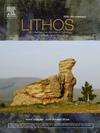Metamorphic evolution and tectonic significance of garnet-bearing amphibolites from the upper valley of the Hatu River, East Kunlun Orogenic Belt
IF 2.9
2区 地球科学
Q2 GEOCHEMISTRY & GEOPHYSICS
引用次数: 0
Abstract
The East Kunlun Orogenic Belt (EKOB), traditionally divided into northern (or Qimantagh Belt), central, and southern segments, has undergone a long and complex evolution. Eclogites exhumed from subduction zones are significant for reconstructing the tectonometamorphic histories of these continental blocks. However, they have not yet been reported from the southern EKOB. In this study, we first identified a suite of garnet-bearing metabasic riverbed cobbles in the upper Hatu valley, southern EKOB, some of which contain calcic clinopyroxene–plagioclase (Cpx–Pl) and/or amphibole–quartz (Amp–Qz) intergrowths typical of omphacite pseudomorphs. The absence of Cpx–Pl symplectite in strongly foliated amphibolites likely indicates complete amphibolitization of clinopyroxene, which may have been greatly enhanced by ductile deformation. The Cpx–Pl symplectite-bearing amphibolites experienced four metamorphic stages: (1) a prograde epidote amphibolite facies stage indicated by primary garnet inclusions, (2) a peak eclogite facies stage with the assemblage of garnet + omphacite + rutile + quartz + amphibole + biotite, (3) a symplectitization stage forming the Cpx–Pl intergrowth, and (4) an amphibolite facies stage forming a kelyphitic rim around garnet. Phase equilibrium modeling supports the eclogite facies conditions of 660 °C–750 °C and 13–16 kbar. Fine-grained garnet and amphibole in thin sodic plagioclase films between quartz grains may have formed as a result of peritectic reactions during partial melting at the eclogite facies stage rather than during decompression. Porphyroblastic epidote embayed by plagioclase and amphibole in the epidote-rich amphibolites likely indicates an interaction between epidote and the intergranular melt. U![]() Pb ages of the metamorphic zircons at ∼460 Ma probably correspond to the Early Paleozoic subduction of the Proto-Tethys Ocean, which may have contributed to the formation of the back-arc basaltic rocks of the Nachitai Group in the southern EKOB. This study supports the Mid-Ordovician as an important growth episode for the multiple subduction–accretionary system of the entire EKOB.
Pb ages of the metamorphic zircons at ∼460 Ma probably correspond to the Early Paleozoic subduction of the Proto-Tethys Ocean, which may have contributed to the formation of the back-arc basaltic rocks of the Nachitai Group in the southern EKOB. This study supports the Mid-Ordovician as an important growth episode for the multiple subduction–accretionary system of the entire EKOB.
东昆仑造山带哈图河上游河谷含石榴石角闪岩的变质演化及其构造意义
东昆仑造山带(EKOB)经历了漫长而复杂的演化过程,传统上分为北段(或奇曼塔格带)、中段和南段。从俯冲带发掘出的榴辉岩对于重建这些大陆块体的构造变质史具有重要意义。但是,尚未有来自南部埃科布控制区的报告。在本研究中,我们首次在EKOB南部的上哈图河谷发现了一套含石榴石的变质基性河床鹅卵石,其中一些含有钙斜辉石-斜长石(Cpx-Pl)和/或角闪石-石英(Amp-Qz)互生物,具有典型的辉长石伪晶型。强片理角闪岩中没有Cpx-Pl共晶岩,可能表明斜辉石完全角闪化,这可能在韧性变形的作用下得到了极大的增强。Cpx-Pl含角闪岩经历了4个变质阶段:(1)以原生石榴石包裹体为特征的渐进式绿长角闪岩相阶段,(2)以石榴石+辉长石+金红石+石英+角闪石+黑云母组合为特征的峰榴辉岩相阶段,(3)形成Cpx-Pl共生的复合阶段,(4)形成围绕石榴石的榴辉岩边缘的角闪岩相阶段。相平衡模型支持660°C - 750°C和13-16 kbar的榴辉岩相条件。石英颗粒之间的钠质斜长石薄膜中的细粒石榴石和角闪孔可能是榴辉岩相阶段部分熔融过程中的包晶反应而不是减压过程中形成的。富含绿帘石的角闪岩中斜长石和角闪石镶嵌的成斑绿帘石可能是绿帘石与粒间熔体相互作用的产物。变质锆石的UPb年龄在~ 460 Ma,可能对应于早古生代原特提斯洋的俯冲,这可能是EKOB南部Nachitai群弧后玄武岩形成的原因。研究结果表明,中奥陶统是整个东西部多俯冲-增生体系的重要发育期。
本文章由计算机程序翻译,如有差异,请以英文原文为准。
求助全文
约1分钟内获得全文
求助全文
来源期刊

Lithos
地学-地球化学与地球物理
CiteScore
6.80
自引率
11.40%
发文量
286
审稿时长
3.5 months
期刊介绍:
Lithos publishes original research papers on the petrology, geochemistry and petrogenesis of igneous and metamorphic rocks. Papers on mineralogy/mineral physics related to petrology and petrogenetic problems are also welcomed.
 求助内容:
求助内容: 应助结果提醒方式:
应助结果提醒方式:


